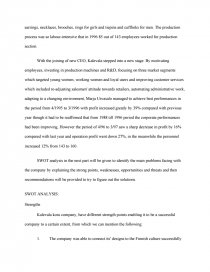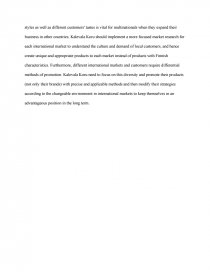Kalevala Koru
Essay by review • November 13, 2010 • Essay • 1,665 Words (7 Pages) • 1,786 Views
Kalevala Koru
Introduction
The history of Kalevala jewellery went back to the Association of Kalevala Women who aimed to safeguard ancient Finnish culture tradition. Making-making was regarded by them as one way to honour national history and culture heritage as well as one way to raise funds for the Association of Kalevala Women. The name Kalevala came from the national epic because of its strong connection
Established in 1937, Kalevala Jewellery started to produce jewellery in 1940. In 1940s, though facing difficulties of lacking raw materials and skilful workforce in production, the jewellery sold very well both at home and abroad partly due to the fact that demand exceeded supply, partly due to its attendances at jewellery exhibitions which enlarged its brand fame. 1950s saw the steady growth of Kalevala till 1960s, however modern jewellery gained an increasing market share at the same time. In the early 70s situation improved a bit then replaced by a sliding down at the end of the decade till the beginning of 80s when the Association had to give financial aid to help it out. Then thanks to a change in fashion in the mid-80s, Kalevala won over new customers when young women wanted big, ethnic jewellery.
The main product ranges of Kalevala were ancient and archaeological jewellery, historical jewellery and modern jewellery. Bronze was used as main raw materials to make jewellery, next was silver and then gold. Bronze jewellery contributed a large part of total production (70%). The silver and gold works accounted for 22 % and 8 % respectively. Almost the entire Kalevala jewellery range was available in both bronze and silver. Every year over 400 models were being produced, of which most were available in various forms, like pendants, earrings, necklaces, brooches, rings for girls and tiepins and cufflinks for men. The production process was so labour-intensive that in 1996 85 out of 143 employees worked for production section.
With the joining of new CEO, Kalevala stepped into a new stage. By motivating employees, investing in production machines and R&D, focusing on three market segments which targeted young women, working women and loyal users and improving customer services which included re-adjusting salesmen' attitude towards retailers, automating administrative work, adapting to a changing environment, Marja Usvasalo managed to achieve best performances in the period from 4/1995 to 3/1996 with profit increased greatly by 39% compared with previous year though it had to be reaffirmed that from 1988 till 1996 period the corporate performances had been improving. However the period of 4/96 to 3/97 saw a sharp decrease in profit by 16% compared with last year and operation profit went down 27%, in the meanwhile the personnel increased 12% from 143 to 160.
SWOT analysis in the next part will be given to identify the main problems facing with the company by explaining the strong points, weaknesses, opportunities and threats and then recommendations will be provided to try to figure out the solutions.
SWOT ANALYSIS:
Strengths
Kalevala koru company, have different strength points enabling it to be a successful company to a certain extent, from which we can mention the following:
1. The company was able to connect its' designs to the Finnish culture successfully in a way of honouring and respecting the legacy and traditions of past generations.
2. The brand image of the company, as well as, the reputation was very strong.
3. They were able to promote the brand by donating the products as gifts to (well-known) ladies inside and outside Finland, such as, first ladies in each country or to royal families.
4. The company has a strong design management through direct contact with famous designers; Stefan Lindfors for example.
5. Good customer orientation: which was one of the major cornerstones in the company's new marketing strategy, aiming to concentrate on different customer segments (rather than focusing only on women of 60s).
6. The company's marketing strategy has a very good focus on retailers, and direct marketing to them.
7. They were able to build high brand loyalty among big number of customers.
8. The members of the "Kalevala Koru Association" have a strong influential network. Among those members was the wife of the president, wife of the minister, and a member of the parliament.
9. The company manufactured a wide range of products and designs to satisfy the variety in tastes and preferences among their customers.
10. Good management system in terms of employee motivation through paying bonuses based on sales and production figures in order to keep high job satisfaction. They were also good in terms of introduction of the automated administration system, from which they were able to minimize paper work, therefore, increasing the efficiency of distribution, production and storing processes.
11. Strong financial situation, in which no bank loans and financial burden took place.
12. Efficient distribution process and channels, through fast delivery to retailers, as well as a 400 jewelry shops all over Finland.
13. Acquisition of "Kaunis Koru Ltd." Which enabled them to gain more competitive advantage in modern jewelry design.
Weaknesses
1. The Kalevala Koru did not have a separate marketing department. The CEO made most of the marketing decisions. She also took an active part in planning the advertising campaigns. However, as a CEO, Usvasalo should have much time to focus on top management. It's better for the company to set up a marketing department to do marketing research and deal with marketing affairs.
2. The Kalevala Koru did not successfully target at a specific segment. The CEO based her marketing strategy on three segments: Young people, working women and loyal users. However, the company did not position products in the mind of this consumer group. It provided products for women of all range of ages.
3. The Kalevala Koru has not successfully developed its overseas markets. First, it focused more on its brand image than on its product details in developing abroad markets. Second, as the worldwide fashions changed, more and more people seemed to prefer jewelry made of silver and gold. The most important point is that Kalevala
...
...






